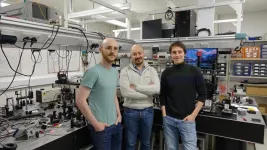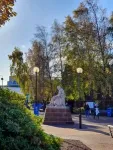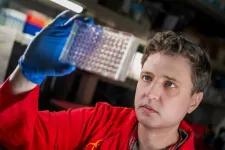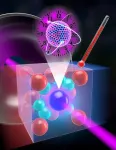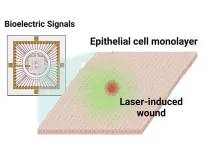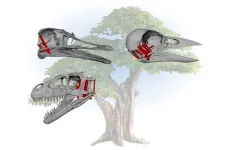(Press-News.org) Researchers at Heriot-Watt University have made a ground-breaking discovery paving the way for a transformative era in photonic technology.
For decades, scientists have theorised the possibility of manipulating the optical properties of light by adding a new dimension—time. This once-elusive concept has now become a reality thanks to nanophotonics experts from the School of Engineering and Physical Sciences in Edinburgh, Scotland.
The team’s breakthrough emerged from experiments with nanomaterials known as transparent conducting oxides (TCOs) - a special glass capable of changing how light moves through the material at incredible speeds. These compounds are widely found in solar panels and touchscreens and can be shaped as ultra-thin films measuring just 250 nanometers (0.00025 mm),smaller than the wavelength of visible light.
Led by Dr Marcello Ferrera, Associate Professor of Nanophotonics, the Heriot-Watt research team, supported by colleagues from Purdue University in the US, managed to “sculpt” the way TCOs react by radiating the material with ultra-fast pulses of light. Remarkably, the resulting temporally engineered layer was able to simultaneously control the direction and energy of individual particles of light, known as photons, a functionality which, up until now, had been unachievable.
The discovery is directly linked to the possibility of processing data at a far greater speed and volume than what is currently available. It is expected to have transformative impact in several key areas such as optical computing and AI, integrated quantum technologies, and ultra-fast physics.
“It is difficult to grasp the advances we will experience in our daily lives as a result of this breakthrough,” explains Dr Ferrera.
“By using a nonlinear material to fully exploit optical bandwidth, companies and major organisations can process so much more information. This will hold huge benefits to the likes of data centres and advancing AI technology, among others, and will underpin exciting new technologies we cannot fully understand at this time.”
Commenting further on the potential future uses arising from this research, Dr Ferrera said: “Society is thirsty for bandwidth. If we are aiming at making a virtual meeting a fully immersive 3D experience, this would demand enormous computational power and processing speed, which only ultra-fast all-optical components can provide. The material properties we are investigating here could increase computational speed by several orders of magnitude, enabling handling much greater volumes of information at a fraction of current energy expenditure.
“What science and technology is trying to do is emulate the human brain but by using electronic hardware. The materials we are working on are the ingredients towards this goal that can lower the energy consumption of these computational units, reducing costs and increasing processing power.”
Dr Wallace Jaffray, a postdoctoral research associate and Sven Stengel, a doctoral researcher, have been working alongside Dr Ferrera on the cutting-edge research at Heriot-Watt University.
The core of their breakthrough lies in the ability to manipulate TCOs to control the speed at which photons travel. This newfound capacity effectively adds a ‘fourth dimension’, enabling extraordinary light transformations, including amplification, the creation of quantum states, and new forms of light control.
Dr Ferrera continues: “Searching for a material that can drastically change under low-energy illumination in an ultra-fast manner has been the quest for the Holy Grail in all-optical technologies since the invention of laser.
“This new class of time-varying media is the biggest leap forward towards the perfect optically controllable material in decades enabling a large variety of novel and exciting effects that scientists all over the world are rushing to attempt. This is a new age in nonlinear optics which targets full light-control without the need of slow electric signals.”
The findings have been published in the peer reviewed journal, Nature Photonics.
Vladimir M. Shalaev, a Distinguished Professor of Electrical and Computer Engineering, Purdue University, who assisted in the research said: “These low-index transparent conductors have brought a real revolution within the field of integrated nonlinear optics, allowing for the effective and energy-efficient manipulation of optical signals on unprecedentedly short time scales.”
Alexandra Boltasseva, a Distinguished Professor of Electrical and Computer Engineering at Purdue University, added: “Our common research effort demonstrates that with these materials we can finally use the variable of time for engineering the optical properties of compounds beyond what is currently possible by using standard fabrication processes.”
Dr Ferrera was recently awarded a share of £6.5m from the UK-Canada Quantum for Science Research Collaboration to advance his research over the next two years.
END
Scientists unlock new dimension in light manipulation, ushering a new era in photonic technology
2025-03-18
ELSE PRESS RELEASES FROM THIS DATE:
Current antivirals likely less effective against severe infection caused by bird flu virus in cows’ milk
2025-03-17
(MEMPHIS, Tenn. – March 17, 2025) As the H5N1 avian influenza outbreak continues, scientists are working to better understand the virus’s threat to human health. The virus has been found in dairy cows’ milk and has infected farm workers, prompting scientists at St. Jude Children’s Research Hospital to study potential treatments. Results showed that in a preclinical model, two FDA–approved flu antivirals generally did not successfully treat severe H5N1 infections. Additionally, the researchers found that the route of infection, whether through ...
Lassa fever vaccine enters phase 1 clinical trial
2025-03-17
Thomas Jefferson University has initiated a phase 1 clinical trial for a Lassa virus (LASV) vaccine developed at Jefferson in collaboration with the University of Maryland, Baltimore (UMB), at the Center of Vaccine Development and Global Health, UMB. Currently, there are no approved vaccines against the Lassa virus. The clinical study is a dose-ranging study that will assess the safety and immunogenicity of the candidate vaccine for both the rabies virus and LASV.
The experimental vaccine is based on an attenuated and killed rabies virus vaccine similar to current rabies vaccines and has an additional ...
Institute for Healthcare Improvement Honors Hebrew SeniorLife’s Orchard Cove and NewBridge on the Charles
2025-03-17
Outpatient primary care clinics at Hebrew SeniorLife’s Orchard Cove and NewBridge on the Charles communities have been recognized by the Institute for Healthcare Improvement (IHI) as Age-Friendly Health Systems — Committed to Care Excellence.
“I want to express my gratitude to the team at Hebrew SeniorLife for your dedication to age-friendly care,” said Leslie Pelton, MPA, Vice President, Institute for Healthcare Improvement (IHI). “Age-Friendly Health Systems and IHI celebrate your recognition as an Age-Friendly ...
Dialing in the temperature needed for precise nuclear timekeeping
2025-03-17
For decades, atomic clocks have been the pinnacle of precision timekeeping, enabling GPS navigation, cutting-edge physics research, and tests of fundamental theories. But researchers at JILA, led by JILA and NIST Fellow and University of Colorado Boulder physics professor Jun Ye, in collaboration with the Technical University of Vienna, are pushing beyond atomic transitions to something potentially even more stable: a nuclear clock. This clock could revolutionize timekeeping by using a uniquely low-energy transition within the nucleus of a thorium-229 atom. This transition is less sensitive to environmental disturbances than modern atomic clocks and has been proposed for tests of fundamental ...
Fewer than half of Medicaid managed care plans provide all FDA-approved medications for alcohol use disorder
2025-03-17
FOR IMMEDIATE RELEASE
Monday, March 17, 2025
Contact:
Jillian McKoy, jpmckoy@bu.edu
Michael Saunders, msaunder@bu.edu
##
As health complications and deaths from alcohol use disorder (AUD) increase in the United States, it is critical that people who could benefit from medications have access to the drugs that the US Food and Drug Administration has approved to treat AUD. Yet, for individuals who have alcohol use disorder and are covered by Medicaid, accessing these medications is difficult; past research indicates that only about 1 in 20 Medicaid enrollees with alcohol use disorder receive these ...
Mount Sinai researchers specific therapy that teaches patients to tolerate stomach and body discomfort improved functional brain deficits linked to visceral disgust that can cause of food avoidance in
2025-03-17
Mount Sinai Researchers Find Specific Therapy That Teaches Patients to Tolerate Stomach and Body Discomfort Improved Functional Brain Deficits Linked to Visceral Disgust That Can Cause Food Avoidance in Adolescent Females with Anorexia Nervosa and other Low-Weight Eating Disorders
Corresponding Author: Kurt P. Schulz, PhD, Associate Professor, Center of Excellence in Eating and Weight Disorders, Icahn School of Medicine at Mount Sinai, New York, and other co-authors
Bottom Line: A trial of interoceptive exposure - a therapy that teaches patients how to tolerate stomach and body discomfort in order to reduce restrictive eating - improved functional deficits in a brain region ...
New ACP guideline recommends combination therapy for acute episodic migraines
2025-03-17
Follow @Annalsofim on X, Facebook, Instagram, threads, and Linkedin
Below please find summaries of new articles that will be published in the next issue of Annals of Internal Medicine. The summaries are not intended to substitute for the full articles as a source of information. This information is under strict embargo and by taking it into possession, media representatives are committing to the terms of the embargo not only on their own behalf, but also on behalf ...
Last supper of 15-million-year-old freshwater fish
2025-03-17
18th March 2025, Sydney: In an Australian first, a team of scientists led by Australian Museum and UNSW Sydney palaeontologist, Dr Matthew McCurry, have described a new species of 15-million-year-old fossilised freshwater fish, Ferruaspis brocksi, that shows preserved stomach contents as well as the pattern of colouration. The research is published today in The Journal of Vertebrate Palaeontology (DOI - 10.1080/02724634.2024.2445684)
Named after Professor Jochen J. Brocks from the Australian National University, who discovered several of the fossilised species at the Australian Museum’s, McGraths Flat fossil site near Gulgong, NSW, Ferruaspis brocksi is the first ...
Slow, silent ‘scream’ of epithelial cells detected for first time
2025-03-17
EMBARGOED UNTIL 3/17/2025, 3:00PM ET
March 17, 2025
Slow, Silent ‘Scream’ of Epithelial Cells Detected for First Time
Team from UMass Amherst uncovers communication by “electric spiking” in cells once thought to be mute, which could enable bioelectric applications
AMHERST, Mass. — It has long been thought that only nerve and heart cells use electric impulses to communicate, while epithelial cells — which compose the linings of our skin, organs ...
How big brains and flexible skulls led to the evolution of modern birds
2025-03-17
Modern birds are the living relatives of dinosaurs. Take a look at the features of flightless birds like chickens and ostriches that walk upright on two hind legs, or predators like eagles and hawks with their sharp talons and keen eyesight, and the similarities to small theropod dinosaurs like the velociraptors of Jurassic Park fame are striking.
Yet birds differ from their reptile ancestors in many important ways. A turning point in their evolution was the development of larger brains, which in turn led to changes in the size and shape of their skulls.
New research from ...
